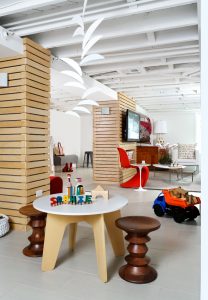We recently purchased a home with an unfinished basement and my goal is to finish it. I’d like to add a second bathroom and a family room. My plan had been to paint the concrete floor but a friend suggested I install a subfloor. This seems like extra work and an added expense. Can you explain why I would need a subfloor and what the long term benefits would be? – Peter
Hello Peter,
Traditionally, basements are cold and damp spaces that are prone to moisture problems. Installing a proper subfloor is the most effective way to prevent those problems and create a space that is warm, soft and dry. Here’s how:
WARM Did you know that 25% of your home’s heat energy is lost through the foundation and concrete slab floor? Insulating your basement floor actually improves the thermal performance of your entire home! In terms of energy and heat, using a R3 rated DRIcore Subfloor R+ in your basement is the equivalent of adding R40 insulation in your attic!
SOFT The basement, especially in the family room, will be a heavy traffic area. Constant, repetitive walking or standing on concrete floors can cause cumulative pain and fatigue. A subfloor will provide added shock absorbency for one’s feet by raising the floor from the hard concrete.
DRY DRIcore Subfloor panels are designed with air gap technology that encourages constant air flow and evaporation/reabsorption of surface moisture emitted from your concrete. Consider a DRIcore Subfloor as a cheap insurance policy; after spending thousands of dollars in your basement, you want to protect your investment by limiting moisture that can cause damage to your walls, flooring and furniture!
When renovating a basement, a quality subfloor is a must to help ensure you have a mold-free, dry, warm and comfortable space for everyone to enjoy! – Dan Sudnik, Renovation Expert, DRIcore
Latest posts by Canadian Home Trends (see all)
- Layer Up – Wrap Your Bathroom In Light - December 21, 2025
- The Power of Rest: Elevate Your Wellness with Better Sleep - December 21, 2025
- VERSATILE KITCHEN DESIGN - December 21, 2025








Before renovating any basement & especially when doing so in older homes with unfinished basements, make sure there are no signs of any prior moisture or water migration through the foundation walls or hydrostatic pressure pushing water up through the basement floor.
Minor moisture migration might appear in the form of efflorescence (that whitish powder build up on the insides of concrete block walls in the basement) which may indicate a failure to the waterproofing system of the time (usually in older homes a mere “tar” like bitumen substance that was rolled on or brushed) has worn away and is allowing moisture migration through the foundation walls. In many homes circa 1950 and earlier, there may never have been any waterproofing applied at all as basements were uninhabited, low head room and typically used as cold storage and housed the furnace or boiler only.
Major water will be visible by way of old water markings on the concrete block unless someone has painted over to mask or hide its presence or wet-to-the-touch areas of direct entry.
Some simple tests to see how “wet” your basement is; tape a patch of plastic say 6″ square to a wall or basement floor and check back a few days later. If you see water droplets; you have moisture migration!
Regardless of the what and how; before you renovate, make sure your waterproofing system and weeper system are intact and functioning in order to best preserve and protect your renovations investment. If you are unsure; contact a BILD accredited contractor for an assessment of your home before you do anything.
Happy renovating!